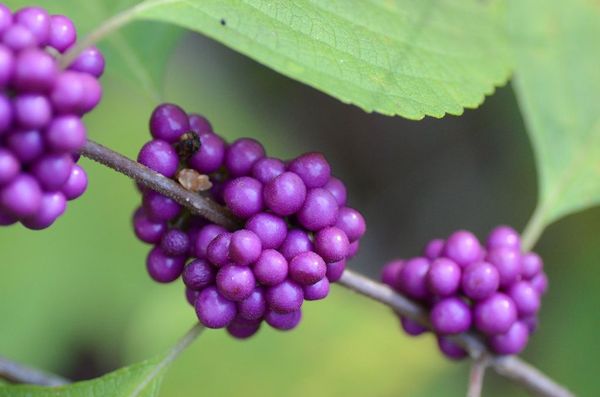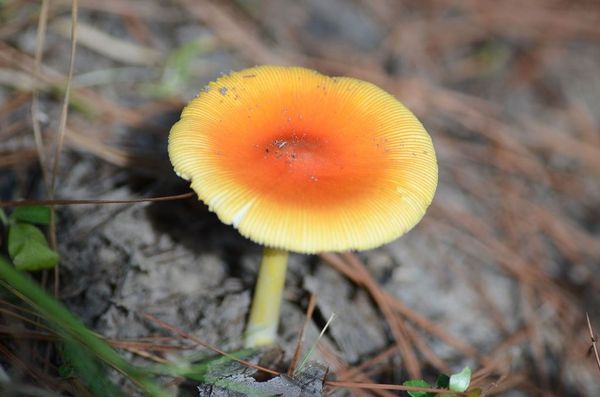By Brandt Mannchen
We made it to the Richards Loop trailhead parking lot for the Lone Star Hiking Trail. Regina was waiting for us. After a brief talk about safety, fun, volunteers, and oil/gas exploitation, we were off down the trail.
 We took the left, or East Fork of the Richards Loop, and soon were gliding through widely space Loblolly Pine trees with a mat of American Beautyberry, seedling hardwood trees, greenbriars, Winged Sumacs, and other woody plants along with a few Post Oaks, Southern Red Oaks, and Black Hickories scattered across the landscape or growing in small groups.
We took the left, or East Fork of the Richards Loop, and soon were gliding through widely space Loblolly Pine trees with a mat of American Beautyberry, seedling hardwood trees, greenbriars, Winged Sumacs, and other woody plants along with a few Post Oaks, Southern Red Oaks, and Black Hickories scattered across the landscape or growing in small groups.
It was the end of September and we prayed for a bit of cool to “nip the bud” of heat that had dogged us all summer. As if in a miracle, our prayers were answered with occasional breezes that cooled down our warm bodies.
We periodically stopped, to take breaks. The trail wound through an open forest (perhaps it could be called a savannah or woodland). We periodically crossed dry streambeds whose incised banks told a story of small farms and “cut and run” logging abuse from the previous 150 years. We were at or near the headwaters of the San Jacinto River Basin.
One reason Sam Houston National Forest was created was to stabilize these upper watershed streams so that siltation, sedimentation, and water pollution would be reduced and water quality and quantity would increase.
 We stopped occasionally to admire beautiful orange mushrooms that were open and showed off to us or were just opening. We marveled at blooming wildflowers including pea plants, gayfeathers, lobelias, bitterweeds, wood sorrels, St. John’s worts, gerardias, Snow-on-the prairie, bonesets, morning glories, and native tall grasses, Little Bluestem and Indian Grass.
We stopped occasionally to admire beautiful orange mushrooms that were open and showed off to us or were just opening. We marveled at blooming wildflowers including pea plants, gayfeathers, lobelias, bitterweeds, wood sorrels, St. John’s worts, gerardias, Snow-on-the prairie, bonesets, morning glories, and native tall grasses, Little Bluestem and Indian Grass.
We stopped in the middle of a Red-cockaded Woodpecker cluster and viewed the cavities that had been pecked in living pine trees and the artificial cavities that had been inserted to increase the population of this endangered bird. This “Family values” bird has a lifestyle that includes young birds that hang around for a few years and help “Ma and Pa” woodpecker take care of the babies each spring. What a neat, competitive, strategy in this forest ecosystem!
About two and one-half miles in, we stopped for lunch at a pond. The water was amber color and its banks were adorned with yellow Water Primrose blossoms. It felt good to be out, breathing the fresh forest air, and seeing the green of fall.
We moved on after lunch and made the turn toward home and began hiking the West Fork of the Richards Loop. The farther we got the hotter it was. We hiked up and down several hills and then moved through the open woods with nary a breeze. What had happened to our windy friend? We could now feel the full intensity of the sun and the 92-degree temperature pressed down on us.
We got to mile four, then five, passed another pond and finally the familiar sound of a road, the crossing of a powerline right-of-way, and the signs that directed us to the parking lot about 200 yards away.
We made it to the parking lot and happily rested. The hike was over but the day had been gorgeous. Our bodies were tired and sore but our spirits and emotions felt filled with the “holy ghost “ of the forest and soared.
We laughed, bid each other goodbye, hugged each other, said our adieus, and then slowly drove out of the parking lot. With a tug at our hearts and a look back over our shoulders we headed back to civilization, tired but refreshed and already dreaming of coming back to our woodland home. See you again soon Sam Houston National Forest!
Photos courtesy of Lisa Samoilenko.